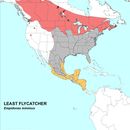zh-TW
在導航的名稱


An extremely small (5 ¼ inches) flycatcher resembling several related species in the genusEmpidonax, the Least Flycatcher may best be separated from its relatives not by appearance, but by its ‘che-BEK’ song. Physical field marks include a green-gray body, white eye ring, pale breast, thin bill, and white wing bars. Male and female Least Flycatchers are similar to one another in all seasons. The Least Flycatcher breeds across much of Canada and northern portions of the United States. Smaller populations occur south of this species main range at higher elevations in the Appalachian Mountains. Least Flycatchers spend the winter in south Florida, Mexico, and Central America, although identifying this species’ in much of its winter range is difficult due to its similarity to other related species. Least Flycatchers breed in open forests with deciduous trees or a mixture of deciduous and evergreen trees. This species may be found in similar habitats on migration. In its winter range, the Least Flycatcher inhabits topical forest edges and thickets. This species primarily eats insects. In northern forests in summer, Least Flycatchers are most likely to be seen darting through the canopy while gleaning insects from leaves or while catching prey in mid-air. Even when active, however, the Least Flycatcher is a difficult bird to identify. Learning this species’ song is crucial to separating it from its relatives, and silent birds are frequently impossible to identify in areas with multipleEmpidonaxspecies. Least Flycatchers are primarily active during the day, but, like many migratory songbirds, this species migrates at night.